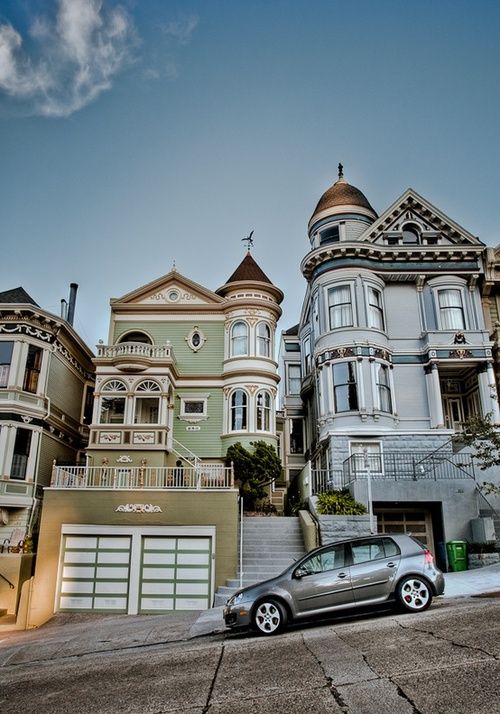Table Of Content

Victorian houses had practical exterior "rooms," often in the form of wraparound porches. These features offer a chance to extend decorative details from the rest of the facade. This Victorian-style house carries intricate railings and columns onto the porch. The developers of Victorian homes were born during the Industrial Revolution. These designers embraced new materials and technologies to create houses like no one had ever seen before. Mass-production and mass-transit (the railroad system) made ornamental architectural details and metal parts affordable.
Common architectural details
While a number of styles have dominated in varying periods of history, there are some typical characteristics that tie this architectural style together. The houses usually have two to three stories with steep, gabled roofs and round towers. On the exterior, there are towers, turrets, and dormers, forming complex roof lines as architects sought to create designs that would pull the eye to the top of the house. And of course, one can’t miss the signature stained glass, decorative woodwork, and bright paint colors—all often framed with a wrap-around porch accented with gingerbread cutouts and spindle work. Queen Anne Victorian homes are the most famous Victorian style architecture that comes to mind.
‘Quintessential Victorian beach house’ lists on popular California island. Take a look - Sacramento Bee
‘Quintessential Victorian beach house’ lists on popular California island. Take a look.
Posted: Thu, 28 Dec 2023 08:00:00 GMT [source]
Queen Anne Style
The Victorian passion for ornamentation translated easily to India under British colonial rule. The Victoria Memorial Hall in Kolkata prominently displays the era’s Indo-Saracenic Revival style. In Mumbai, the Chhatrapati Shivaji Terminus railway station combines Victorian Italianate, Gothic Revival, and traditional Mughal motifs into an exuberant architectural hybrid. In Australia, the Royal Exhibition Building in Melbourne hosted the 1880 Melbourne International Exhibition.
Types of Victorian Style Houses

As Realtor explains, they're also known for additions such as towers, turrets, and large wrap-around porches. Here's your complete guide to Victorian style homes, from some of the key styles and their quirks to common architectural details and ways you can incorporate a little Victorian flair, regardless of when your home was built. After all, with vintage home design trends making a huge comeback in recent years, you just might want to add a little Victorian twist to your space. Some large Victorian homes feature outdoor living spaces extending from the main level to the upper level.
Historic Hillforest Victorian House Museum Now Open for the Season - Eagle 99.3 FM WSCH
Historic Hillforest Victorian House Museum Now Open for the Season.
Posted: Fri, 05 Apr 2024 07:00:00 GMT [source]
Inside the Queen Anne House
During the 1840s when the Victorian era was just gearing up, Italianate style houses became the hot new trend. The style spread quickly across the United States via widely-published Victorian pattern books, many still available in reprints. With low roofs, wide eaves, and ornamental brackets, Victorian Italianate houses are reminiscent of an Italian Renaissance villa.
You’ll often find crown molding, window and door trim, and intricate staircases. Victorian homes are more formal, so there may be many “parlors” or living rooms, and typically feature a formal dining room. There may also be hidden nooks, balconies, and high ceilings, adding to the grandeur of a Victorian era home.
Where to see Victorian design
"Homes were built to create public and private areas, as most Victorian families would entertain multiple times a week. Houses had elaborate floor plans with each room sectioned off for a specific function." Despite roots in the English “Queen Anne Movement”—a return to early, vernacular architecture—it is here a peculiarly American style in its mass-produced ornamentation (including “gingerbread”) and lavish use of wood. The Northeast, already heavily populated in the 1880s, has comparatively fewer examples that you might expect. Go south and west, however, and the style becomes more popular and more fanciful. The West Coast and resurgent areas of the New South have the most dizzying examples.
Within this naming and classification scheme, it followed Georgian architecture and later Regency architecture and was succeeded by Edwardian architecture. Victorian architecture developed through the influence of economic growth, expanding wealth, and industrialization which enabled mass production of building materials and components. Firstly, the Victorian period saw sizable economic expansion and wealth creation, including a growing middle class. New railway transport enabled building at scale, facilitating suburban growth. Secondly, industrialization brought about the mass production of bricks, woodwork, trim, and other building materials transportable by rail.
Scott was a leading proponent of the Victorian Revival style, designing prominent buildings, including the Albert Memorial in London and St Pancras railway station. His Victorian structures displayed intricate stonework and a return to medieval forms, reacting against the rigid orderliness of 18th-century Georgian classicism. Scott believed Victorian architecture had strong moral associations with England’s Christian heritage that were lacking in classical motifs. At the same time, Scott engaged with modern structural advances, using iron and glass to create soaring interiors filled with light. The sheer variety of Scott’s commissions, spanning both secular and religious buildings across Britain, cemented his reputation. He restored churches like Westminster Abbey while also designing new university buildings in Oxford and Cambridge.
In Great Britain, 'Victorian' homes can be classified as really any structures developed during the reign of Queen Victoria in the 19th Century. These include the ornate country houses and estates outside the cities to simple rowhouses, like those above in Cambridge, unfussy in the exterior, built for efficiency in the cities for all classes of people. If you’re looking for a home that can suit any class or quality, Victorian house style might suit your aesthetic. Ranging from ornate dwellings with latticework reaching up to every corner, to row houses built in a post-industrial era for Great Britain, Victorian homes cover a wide swath of territory when it comes to traditional architectural forms.
Victorian architecture encompasses various revival architectural styles popular during the Victorian era, including Gothic Revival, Italianate, Second Empire, Queen Anne, and others. Common features include steeply pitched roofs, towers, turrets, bay windows, stained glass, ornate woodwork and trim, bright exterior paint colors, and wrap-around porches. New mass-production techniques and materials, such as plate glass, also enabled more elaborate building designs. Victorian architecture originated in the United Kingdom during Queen Victoria’s reign and encompasses several revival architectural styles popular at that time. These styles include Gothic Revival, Italianate, Second Empire, Stick, and Queen Anne. There was an explosion of distinct architectural styles made possible by the expansion of the architectural profession and advances in mass production brought about by the Industrial Revolution.
Additionally, the amount of space created by the high ceilings allowed room for the inclusion of elaborate molding, decorative plasterwork, and intricate detailing on the ceilings themselves, all of which were hallmarks of Victorian design. Step back to an era of grandeur and opulence, where ornate details and architectural splendor reigned supreme. In this blog, we’ll embark on a journey through the enchanting world of Victorian architecture, uncovering the secrets behind their distinctive design and delving into the historical context that shaped these iconic homes. Shingle style homes are known for their simplicity and make the most popular choice for summer or weekend houses of the rich and famous. Despite their misleading name, Shingle style houses are actually made from clapboard or brick.
Appropriately named, the Octagon style home has eight sides, making homes feel airy and full of light. They often have low-pitched roofs, a domed shape, a cupola, and a spiral staircase in the middle of the home. One of the easiest ways to add a Victorian twist to your home is to use the colors of the era, as MasterClass suggests — opt for navy blue, burgundy, deep brown, and other darker, muted hues. Decorative woodwork is also a must, whether you incorporate it on your home's exterior or in the interior. Consider adding wallpaper to make a statement, or bring in some of the preferred Victorian fabrics, such as velvet and heavy silk damask, in your cushions and drapery, as Impressive Interior Design advocates.

No comments:
Post a Comment